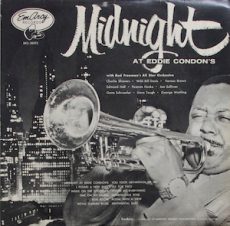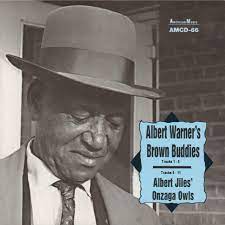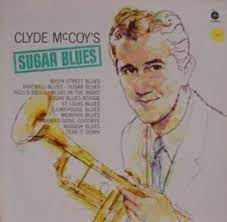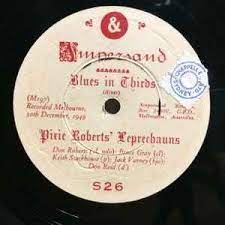
Daily Dose Of Jazz…
Vernon Brown was born on January 6, 1907 in Venice, Illinois. He began his career as a jazz trombonist playing in St. Louis, Missouri with Frankie Trumbauer in 1925, and then moved through a variety of groups at the end of the 1920s and into the 1930s, including those of Jean Goldkette, Benny Meroff, and Mezz Mezzrow.
In 1937 Brown joined Benny Goodman’s orchestra, remaining there until 1940. While only soloing occasionally with Goodman, this association got him well known. The Forties saw him performing with Artie Shaw, Jan Savitt, Muggsy Spanier, and the Casa Loma Orchestra. In the 1940s, Brown switched focus from swing to Dixieland, playing often in studio recordings and working with Sidney Bechet.
Brown performed with Louis Armstrong and his All Stars for the ninth Cavalcade of Jazz concert in 1953 at Wrigley Field in Los Angeles, California. The concert also featured that day were Roy Brown and his Orchestra, Don Tosti and His Mexican Jazzmen, Earl Bostic, Nat “King” Cole, and Shorty Rogers and his Orchestra.
He led his own band in the Pacific Northwest in 1950 and did reunion tours with Goodman in that decade. He worked with Tony Parenti in 1963, and remained a studio musician into the early-1970s
Trombonist Vernon Brown, who later in his life lived in Roslyn Heights, New York, died in Los Angeles on May 18, 1979.
More Posts: bandleader,history,instrumental,jazz,music,trombone

Daily Dose Of Jazz…
Albert Warner was born on December 31, 1890, in the Tremé neighborhood of New Orleans, Louisiana. Though his father was a string bass player, he didn’t seriously pick up the trombone until he was twenty-two years old. Taking lessons from one of his half-brothers, Ulysses Jackson, as well as Arthur Stevens and Honoré Dutrey. His main influences in his youth came from hearing Freddie Keppard, Vic Gaspard, and Baptiste Delisle.
His first professional jobs were playing for dance bands, including those led by “Big Eye” Louis Nelson, Kid Rena, Wooden Joe Nicholas, Buddy Petit, and Chris Kelly. In 1932 Warner joined the Eureka Brass Band and remained a regular member of this group until his death in 1966. His musical interplay with Charles Sonny Henry in the Eureka band during the late 1940s and 1950s is remembered by many for its intricacy and beauty.
The early Forties saw Albert playing and recording with Bunk Johnson and George Lewis. He would record often throughout the 1950s and in the Sixties he could be found playing frequently at Preservation Hall, accompanying the Preservation Hall band on a number of tours with Kid Sheik and the Eureka Brass Band. He went on one Memphis tour with Billie and DeDe Pierce in 1965.
Warner left behind a number of sessions recorded and released by Commodore, Pax, Folkways, Atlantic, and American. The album Bunk Johnson 1942/1945, Eureka Brass Band and The Eureka Brass Band in Rehearsal, a number of recordings with Charlie Love, Peter Bocage with His Creole Serenaders and the Love-Jiles Ragtime Orchestra, released by American. He also appeared on other American label albums recorded by Punch Miller, John Casimir, Kid Sheik and appeared on Atlantic’s Jazz at Preservation Hall series.
Trombonist Albert Warner, who performed in the traditional and brass band genres, transitioned on September 10, 1966 in New Orleans.
More Posts: bandleader,history,instrumental,jazz,music,trombone

Daily Dose Of Jazz…
Clyde Lee McCoy was born December 29, 1903 in Ashland, Kentucky to the family that feuded with the Hatfields. He began mastering the trumpet without formal instruction, after the family moved to Portsmouth, Ohio in 1912. This led him to perform regularly at church and school affairs. Five years later he was performing on the Cincinnati riverboats, and on the Mississippi River side-wheelers the Island Queen and the Bernard McSwain. He became one of the youngest musicians on the river at age 14.
In 1920, accepting an invitation for a small band to play at a Knoxville, Tennessee resort, his Chicago Orchestra rehearsed on the train and won the approval of George Whittle and the patrons of the Whittle Springs Hotel and Spa. After a two month engagement the band officially became known as the Clyde McCoy Orchestra.
In the late 1920s McCoy developed the signature “wah-wah” sound by fluttering a Harmon mute in the bell of his trumpet. In 1967, a similar effect was made for electric guitar with the introduction of the Vox Clyde McCoy Wah-Wah Pedal. Having nothing to do with the use or development of the pedal,Clyde’s name was only used for promotion.
Over the course of a seven decade career Clyde was based at various times in New York City, Los Angeles, California and Chicago, Illinois. He is best remembered for his theme song Sugar Blues, written by Clarence Williams and Lucy Fletcher, and also as a co-founder of Down Beat magazine in 1935. The song was performed with vocals by Bob Wills and his Texas Playboys, Fats Waller and Ella Fitzgerald.
Trumpeter and bandleader Clyde McCoy, who has a star on the Holywood Walk of Fame, transitioned on June 11, 1990 in Memphis, Tennessee.
More Posts: bandleader,history,instrumental,jazz,music,trumpet

Daily Dose Of Jazz…
David Louis Bartholomew was born Davis Bartholomew on December 24, 1918 in Edgard, Louisiana and initially learned to play the tuba, then took up the trumpet with lessons from Peter Davis, who also tutored Louis Armstrong. Around 1933 he moved with his parents to New Orleans, Louisiana where he played in local jazz and brass bands, including Papa Celestin’s. He played in Fats Pichon’s band on a Mississippi riverboat and took charge of his band in 1941. After a stint in Jimmie Lunceford’s band he joined the US Army during World War II and developed writing and arranging skills as a member of the 196th Army Ground Forces Band.
At the end of the war he returned to New Orleans and towards the end of 1945 he started leading his own dance band, Dave Bartholomew and the Dew Droppers, named after a now-defunct local hotel and nightclub, the Dew Drop Inn. Their popularity was a model for early rock ‘n’ roll bands the world over. In 1947, they were invited by club owner Don Robey to perform in Houston, Texas, where Bartholomew met Lew Chudd, the founder of Imperial Records.
His band made their first recordings for De Luxe Records in 1947 and their first hit was Country Boy, reached No. 14 in the national Billboard R&B chart in early 1950. Prominent members of the band, besides Bartholomew on trumpet and occasional vocals, were the saxophonists Alvin Tyler, Herb Hardesty, and Clarence Hall, the bass player Frank Fields, the guitarist Ernest McLean, the pianist Salvador Doucette, and the drummer Earl Palmer. They were later joined by the saxophonist Lee Allen.
Two years after their first meeting in Houston, Texas he was asked by Lew Chudd to become Imperial’s A&R man in New Orleans. Dave went on to produce singer Jewel King, and a young pianist Fats Domino, who went on to have great success with their collaboration. He went on to work at several labels including his own Broadmoor Records.
The 1970s and 1980s had Bartholomew leading a traditional Dixieland jazz band in New Orleans, releasing an album, Dave Bartholomew’s New Orleans Jazz Band in 1981. He produced numerous hit songs and was inducted into the Songwriters Hall of Fame, the Rock and Roll Hall of Fame, and the Louisiana Music Hall of Fame.
Trumpeter, bandleader, composer, arranger and record producer Dave Bartholomew, who was prominent in the New Orleans music scene and active in rhythm and blues, big band, swing music, rock and roll, New Orleans jazz, and Dixieland, transitioned from a heart attack in Metarie, Louisiana on June 23, 2019.
More Posts: aranger,bandleader,composer,history,instrumental,jazz,music,record producer,trumpet

Daily Dose Of Jazz…
Donald Bruce Roberts was born on December 4, 1917 in Melbourne, Australia and studied both clarinet and saxophone. Known to the world by his nickname Pixie, he started his music career in the 1930s.
Over the course of his career Pixie was a member of the Don Roberts’ Wolf Gang, Graeme Bell And His Australian Jazz Band, Graeme Bell And His Dixieland Jazz Band, Graeme Bell And His Orchestra, Graeme Bell’s Original Four, Pixie Roberts’ Leprechauns, Roger Bell’s Jazz Gang, The Bell-Lyttelton Jazz Nine, The Bell-Lyttelton Jazz Ten, The Bell-Lyttelton Jazz Twelve.
He was among the co-founders of the Australian jazz label Swaggie Records. Clarinetist and saxophonist Pixie Roberts transitioned on August 16, 1992 in his home city of Melbourne. He was 74.



